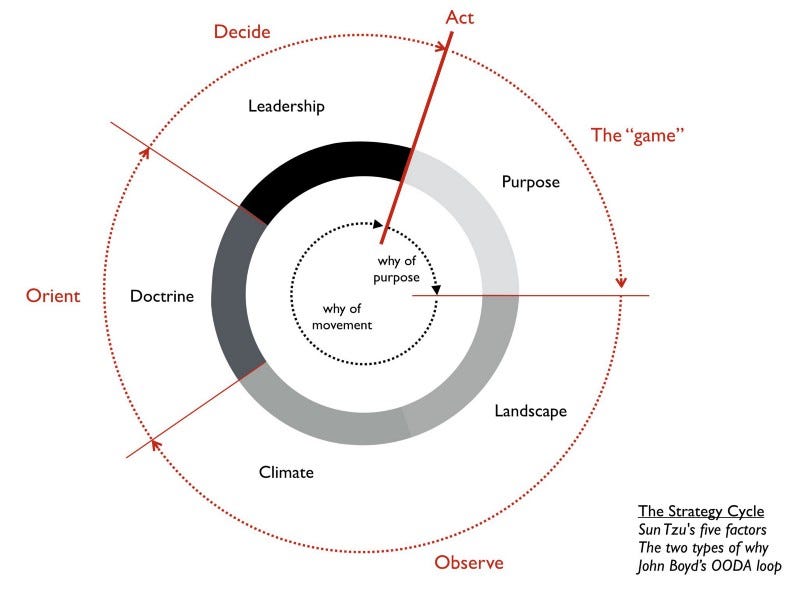In my last post, Towards Burja Mapping, I proposed a new kind of strategic mapping, Burja Mapping (or power mapping, or empire mapping). Burja Mapping combines Samo Burja’s Empire Theory with a form of mapping similar to that pioneered by Simon Wardley.
This post marks the beginning of a series of follow-up posts, aiming to develop and share a more robust version of Burja Mapping. This post will address the question, “Why map power?”
Mapping and the Strategy Cycle
Wardley discusses strategy as a whole in terms of this cycle, which relates Sun Tzu’s five factors, Boyd’s OODA loop, and the two “why’s”:

The visual component of mapping is primarily focused on the “Landscape” factor, which informs the rest of the strategy cycle: observation, orientation, decision, and action; purpose, landscape, climate, doctrine, and leadership. Mapping allows you to assess the landscape and to affect the landscape (through doctrine, gameplay).
Mission statements, goal setting processes, and other frameworks help you answer the question “Why?” Financial statements and realities constrain what is possible, answering the question “How much?” Although less commonly used, Wardley Mapping and the more recent Maturity Mapping help you answer the question “What?” and “How?” By contrast, Burja Mapping lets you answer the question “Who?”
Asking this question may appear useless or unnecessary, since it seems to have a blindingly obvious answer. You might say: “We already know who — it’s me and my team — and we already have an org chart.” However, this is demonstrably insufficient.
First, the power that affects our landscape is decidedly not limited to the people in front of us (our boss, direct reports, etc.) or even within our own team or organization. Ben Landau-Taylor of Bismarck Analysis compares power to the water a fish breathes in: so ubiquitous that we risk being blind to it, but no less important for us making that error. In particular, we might be blind to the ways that power affects us not just from above (“High”) but from below (“Mid” or “Low”) and beyond (“Out”).
I don’t know how commonly used org charts are, as I’ve personally never worked in an organization with a formal org chart. I have, however, used the GlassFrog tool for visually documenting Holacracy areas of responsibility. Org Charts and GlassFrog do recognize the value of visual representations of hierarchy and areas of power, because they provide value in terms of orientation. However, they typically represent what is officially the case, or what “should be,” rather than than what is. Burja Mapping empowers anyone to create a map that reflects their own assessment of the current landscape of power, at any scale, in any organization or empire. The potential here is similar to that of Wardley Mapping, where a company may have an official strategy, official goals, official projects, but an independent actor within the company may see that those are underwhelming and unlikely to succeed, and forge their own path ahead with Wardley Mapping and associated doctrine and gameplay.
However, Wardley Mapping is necessary but insufficient for mapping power dynamics. Yes, you do need to map users and their needs, and those are often people. Yes, specific teams can be put in charge of specific areas of the map, using different cultures. Still, these tools, at least in my experience, are by default useful for the complicated domain (in Cynefin terms). They are less useful for the the subsection of the complex domain that involves humans, power dynamics, and political/social capital.
Of course, it’s possible that my skill in Wardley Mapping is not sufficiently developed. Perhaps if I were more skilled, I could use maps to steer my team and organization to where we need to go. But I would produce a simple, incomplete, but telling example to the contrary: Simon Wardley’s own history with mapping. In the narrative portions of his book, he sometimes says that he had difficulties with socio/political power + capital in executing his strategies, e.g. at Zimki:
The nail in the coffin was when I was told by one of the board that the members had decided to postpone the open sourcing of our platform and that they wanted me to immediately sign contracts cancelling our revenue generating services at an unspecified date to be filled in later. As the person who normally chaired the board meeting then I was annoyed at being blindsided, the choice and myself. Somehow, in my zeal to create a future focused on user needs and a meaningful direction, I had forgotten to gain the political capital I needed to pull it off. I might have created a strong purpose and built a company capable of achieving it but I had messed up big time with the board. It wasn’t their fault; they were focusing on what was core to the parent company and their needs.
Looking at Zimki in terms of Empire Theory, coordination was strong between Simon the CEO (live, high) and his team (live, presumably mostly mid and low players), but not with the board of the parent company (dead, out). This led to them removing the borrowed power he was using to pursue his (live, strategically sound) direction.
I don’t mean to pick on Simon — he’s just a good example rhetorically, because he invented this whole mapping thing. He exemplifies a trap that many of us, certainly including myself, can and have fallen into: developing the perfect solution, but seeing it fail solely because of inertia, politics, people, and — you guessed it — power.
All projects that involve multiple humans will succeed or fail on the basis of power. Skill in power is always needed, in any leadership position (including unofficial leadership positions). Without being savvy at perceiving and affecting power dynamics, you are sure to fail. You can have an excellent vision, but you need to persuade others to help you realize it. In many cases, you also need to do offensive + defensive gameplay to prevent others from hindering or hurting you as you attempt to do so. On the other hand, if you can notice, use, and grow political capital, you will find your projects are more likely to succeed.
Empire Theory provides a basis for us to understand power more fully. We can then learn to recognize and use it in competitive landscapes we care about with Burja Mapping. The standard fare of annual goals and financial statements, and even less common tools like Wardley Maps, are all still useful and relevant. Power mapping provides a complement to these tools. When used together, these tools produce sociotechnical strategic intelligence. This means that you are skilled at using Wardley Maps, financial statements, and other tools in combination with Burja Maps, and letting your gameplay be informed by a more nuanced orientation towards the landscape.
In the next post, I’ll look more closely into the foundations of mapping in general and Wardley Mapping in particular, to more firmly establish a grounds for articulating Empire Theory in terms of maps.
